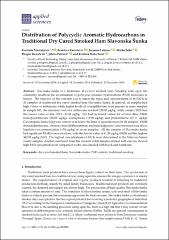Distribution of Polycyclic Aromatic Hydrocarbons in Traditional Dry Cured Smoked Ham Slavonska Šunka

View/
Date
2019Author
Mastanjević, Krešimir
Kartalović, Brankica
Lukinac, Jasmina
Jukić, Marko
Kovačević, Dragan
Petrović, Jelena
Habschied, Kristina
Metadata
Show full item recordAbstract
Slavonska šunka is a traditional dry-cured smoked ham. Smoking with open fire
commonly results in the accumulation of polycyclic aromatic hydrocarbons (PAH) molecules in
tissues. The objective of this research was to assess the types and concentrations of 16 PAHs in
30 samples of traditional dry-cured smoked ham Slavonska šunka. In general, all samples had
high values of anthracene while higher levels of acenaphthylene were present in some samples.
In sample SS1, the maximal value for anthracene reached 228.03 µg/kg, while sample SS28 had
the lowest value of this PAH—33.38 µg/kg. SS1 had increased values for several other PAHs:
benzo[a]anthracene (54.03 µg/kg), acenaphtene (19.90 µg/kg) and phenanthrene (27.11 µg/kg).
Cancerogenic benzo[a]pyrene content was below the limit of quantification for all samples. PAH4
(benzo[a]anthracene, chrysene, benzo[b]fluoranthene and benzo[a]pyrene) concentrations were above
legislative recommendation (>30 µg/kg) in seven samples. All the samples of Slavonska šunka
had significant PAH16 concentrations, with the lowest value of 61.30 µg/kg (SS28) and the highest
462.83 µg/kg (SS1). The highest concentrations of PAHs were determined in the Vukovar–Srijem
county samples. Another conclusion from this research is that samples smoked with elm tree showed
high PAH concentrations in comparison to the ones smoked with beech and hornbeam.
